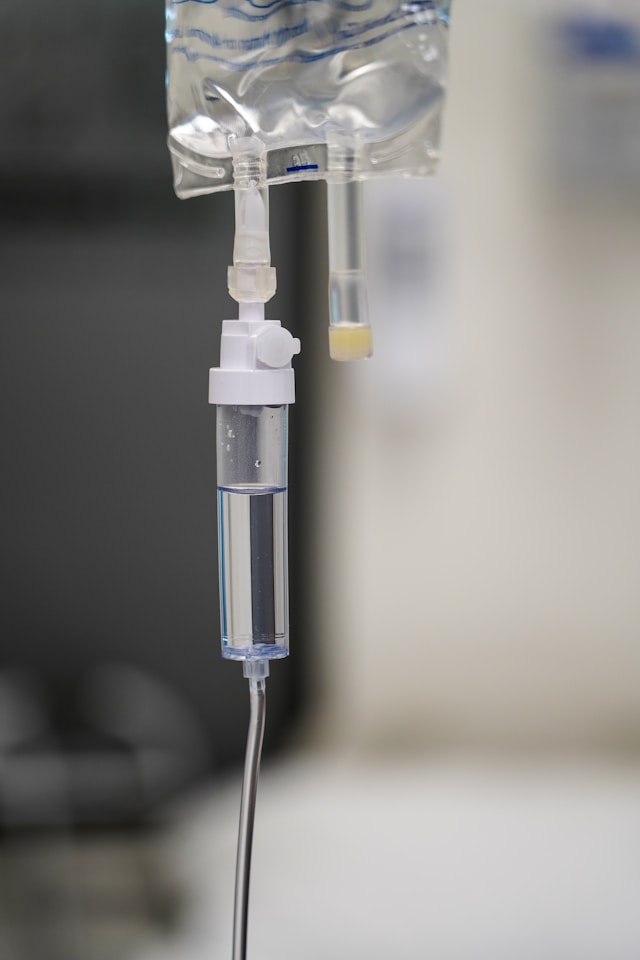
IVIG Therapy: What to Expect and Who It Helps


Dr. Chen is a board-certified immunologist with over 15 years of experience treating autoimmune and immunodeficiency disorders. She specializes in IVIG therapy and has published extensively on immune system treatments.
Medical Disclaimer
Intravenous immunoglobulin (IVIG) therapy is a medical treatment that delivers concentrated antibodies collected from thousands of healthy blood donors directly into your bloodstream. For people with immune deficiencies, autoimmune diseases, and certain neurological conditions, IVIG can be life-changing—providing missing immune protection, modulating overactive immune responses, or reducing inflammation. Understanding what IVIG is, who benefits from it, and what to expect during treatment helps you navigate this important therapy.
Key Highlights
- IVIG contains pooled antibodies (immunoglobulins) from thousands of healthy donors, providing immune protection or immune modulation depending on the condition being treated.
- Common uses include primary immune deficiencies, CIDP, certain autoimmune conditions, and neurological disorders, with infusions typically given every 3-4 weeks.
- Most patients tolerate IVIG well, with the most common side effect being headaches that usually improve with hydration, slower infusion rates, and subsequent treatments.
What Is IVIG
Intravenous immunoglobulin is a blood product containing concentrated antibodies (primarily IgG) purified from pooled plasma donated by thousands of healthy individuals. This pooling creates a diverse antibody mixture providing protection against a wide range of infections and pathogens that the donors' immune systems have encountered.
IVIG is manufactured through careful screening, testing, and purification processes to ensure safety. Donors are screened for infectious diseases, and the plasma undergoes viral inactivation and removal procedures. The final product contains primarily IgG antibodies, with small amounts of IgA and IgM, plus proteins and sugars that stabilize the solution.
According to the American Academy of Allergy, Asthma & Immunology, IVIG has been used safely for decades to treat various immune and inflammatory conditions.
How IVIG Works
IVIG works through different mechanisms depending on the condition being treated:
For Immune Deficiencies: Patients who cannot produce adequate antibodies receive replacement antibodies from IVIG, providing passive immunity that protects against bacterial and some viral infections.
For Autoimmune and Inflammatory Conditions: IVIG modulates immune system function through complex mechanisms not fully understood. It may neutralize harmful autoantibodies, regulate immune cell function, reduce inflammation, and affect complement system activity.
For Neurological Conditions: In diseases like CIDP or myasthenia gravis, IVIG may reduce antibody-mediated nerve or muscle damage and modulate immune responses attacking nerves.
The exact mechanisms by which IVIG benefits different conditions remain areas of active research, but clinical effectiveness has been well-established for many diseases.
Conditions Treated with IVIG
IVIG is FDA-approved and commonly used for numerous conditions:
Primary Immune Deficiencies: Common Variable Immune Deficiency (CVID), X-Linked Agammaglobulinemia (XLA), Hyper-IgM Syndrome, Specific Antibody Deficiency, and other antibody deficiency disorders. For these conditions, IVIG is lifelong replacement therapy.
Neurological Disorders: Chronic Inflammatory Demyelinating Polyneuropathy (CIDP), Guillain-Barré Syndrome, Multifocal Motor Neuropathy, Myasthenia Gravis, and some cases of autoimmune encephalitis.
Hematologic Conditions: Immune Thrombocytopenic Purpura (ITP), particularly acute severe cases or when other treatments fail.
Autoimmune/Inflammatory Conditions: Kawasaki disease (acute treatment in children), dermatomyositis, and some cases of inflammatory myopathies.
Off-Label Uses: Some neurologists and rheumatologists use IVIG off-label for refractory lupus, certain vasculitis syndromes, chronic inflammatory conditions not responding to other treatments, and other conditions where immune modulation may help.
According to the Mayo Clinic, IVIG has become an important therapeutic option for many immune-mediated conditions.
What to Expect During IVIG Therapy
Pre-Infusion Preparation: Before your first IVIG, you'll need baseline blood work including immunoglobulin levels (IgG, IgA, IgM), complete blood count, kidney and liver function, and sometimes IgA level specifically (patients with IgA deficiency have higher reaction risk). Arrive well-hydrated—drink plenty of water the day before and morning of your infusion.
Pre-Medications: Most patients receive pre-medications 30-60 minutes before IVIG to reduce reaction risk. Common pre-meds include acetaminophen for headache prevention, antihistamines like diphenhydramine or cetirizine for allergic reactions, and sometimes corticosteroids for patients with higher reaction risk.
IV Placement: A nurse will place an IV catheter in your arm or hand. Good hydration makes veins easier to access.
Starting the Infusion: IVIG begins at a slow rate, gradually increasing as tolerance is assessed. Your first infusion will be slowest (often 4-6 hours) to carefully monitor for reactions. Subsequent infusions may be faster (2-3 hours) once you've demonstrated good tolerance.
During Infusion: You'll be monitored throughout treatment with periodic vital sign checks and nursing assessments. Most patients read, watch videos, work on laptops, or rest during their infusion. Bringing entertainment, snacks, water, and comfort items (sweater, pillow) makes the time pass more pleasantly.
Post-Infusion Monitoring: After your IVIG completes, you'll remain for observation (typically 30-60 minutes, longer for first infusions) to ensure no delayed reactions occur.
Frequency: Most patients receive IVIG every 3-4 weeks, though some need every 2-3 weeks and others can extend to 5-6 weeks. Frequency depends on your condition, how quickly your body uses the immunoglobulin, and maintaining protective antibody levels.
Common Side Effects and Management
Headaches: The most frequent IVIG side effect, occurring in 20-50% of patients. Range from mild to severe and may last hours to several days. Management strategies include staying extremely well-hydrated before and during infusion, slower infusion rates, taking acetaminophen or ibuprofen before and after infusion, IV hydration before or after IVIG, and switching IVIG brands if headaches persist.
Flu-Like Symptoms: Fatigue, muscle aches, chills, or mild fever can occur, usually resolving within 1-2 days. These often improve with subsequent infusions.
Nausea: Some patients experience mild to moderate nausea during or after IVIG. Anti-nausea medications, eating lightly before infusion, and ginger tea may help.
Flushing or Chills: Temperature regulation changes during infusion. Slowing infusion rate usually helps flushing; warm blankets address chills.
Back Pain: Some patients experience lower back pain during IVIG, possibly related to changes in blood viscosity or kidney filtration. Slowing the infusion rate usually resolves this.
Infusion Reactions: True allergic reactions (hives, itching, chest tightness, shortness of breath, blood pressure changes) are uncommon but possible. Stopping the infusion and providing medications usually manages these effectively.
Aseptic Meningitis: Rare but serious complication causing severe headache with stiff neck, fever, and light sensitivity. Requires immediate medical evaluation. More common at higher IVIG doses.
Thrombosis: Very rare risk of blood clots, particularly in elderly patients, those with cardiovascular risk factors, or patients receiving high-dose IVIG. Adequate hydration reduces risk.
Hemolysis: Uncommon breakdown of red blood cells, more likely in patients with blood type A. Monitoring blood counts identifies this.
Most side effects are mild and improve over time as your body adjusts. Switching IVIG brands, adjusting infusion rates, or modifying pre-medications can address persistent issues.
Different IVIG Products
Multiple IVIG brands exist (Gammagard, Privigen, Octagam, Gamunex, Carimune, Flebogamma, and others), all containing immunoglobulin G but differing in:
IgA Content: Some products contain minimal IgA (important for IgA-deficient patients who may react to IgA-containing products).
Sugar Content: Products use different stabilizers (sucrose, maltose, glycine). Patients with kidney disease should avoid sucrose-containing IVIG.
pH and Osmolality: These factors affect tolerability and side effect profiles.
Manufacturing Process: Each manufacturer's purification process creates subtle differences in final product composition.
Patients often tolerate some brands better than others. If you experience persistent side effects with one IVIG brand, switching to another may improve tolerability while maintaining therapeutic benefit.
IVIG vs. SCIG (Subcutaneous Immunoglobulin)
For immune deficiency patients, immunoglobulin replacement can be given two ways:
IVIG (Intravenous): Infused into vein every 3-4 weeks at infusion center or home with nurse. Provides bolus dose creating peak-and-trough antibody levels. Requires less frequent treatments but involves IV access and longer appointments.
SCIG (Subcutaneous): Small amounts injected under skin 1-2 times weekly at home by patient or caregiver. Maintains steadier antibody levels. Requires more frequent self-treatment but offers independence and avoids IV placement.
Both are equally effective for immune deficiency. Choice depends on lifestyle, vein access, personal preference, and tolerability. Many patients try both methods before deciding. Some insurance plans prefer one over the other. This article focuses on IVIG, but SCIG is an important alternative worth discussing with your immunologist.
Living with Conditions Requiring IVIG
Treatment Adherence: For immune deficiencies, maintaining consistent IVIG schedule is essential—missing infusions drops antibody protection and increases infection risk. For autoimmune/neurological conditions, consistency maintains disease control.
Infection Prevention: Even on IVIG for immune deficiency, practice good hygiene, stay current on recommended vaccines (discuss timing with your immunologist), and avoid unnecessary infectious exposures.
Hydration: Drinking plenty of water in the 24 hours before infusion improves tolerability and reduces side effect risk—aim for 8-10 glasses.
Planning Around Infusions: Schedule important activities avoiding the day after infusion when side effects are most likely. Many patients plan infusions for Fridays, allowing weekend recovery.
Medical Alert Information: Wear medical identification noting your condition and IVIG therapy in case of emergency.
Travel Considerations: Plan IVIG timing around travel, or arrange treatment at centers near vacation destinations. Home infusion nursing may travel with you or SCIG offers more travel flexibility.
Monitoring Response: For immune deficiency, periodic trough IgG levels (measured just before your next infusion) ensure dosing adequacy. For other conditions, disease-specific monitoring tracks treatment effectiveness.
Cost and Insurance Considerations
IVIG is one of the most expensive medications, typically costing $5,000-25,000+ per dose depending on body weight and product used:
Insurance Coverage: All insurance plans including Medicare cover IVIG for FDA-approved indications as medically necessary treatment. Prior authorization is typically required but approval is standard for appropriate diagnoses.
Lifetime Treatment: For immune deficiencies, IVIG is lifelong therapy. Understanding this helps with long-term insurance and financial planning.
Copay Assistance: IVIG manufacturers and specialty pharmacies offer copay assistance programs that can significantly reduce out-of-pocket costs for insured patients.
Patient Assistance: For uninsured patients, the Immune Deficiency Foundation and manufacturers may help access treatment through assistance programs.
Frequently Asked Questions
What is IVIG made from?
IVIG is made from pooled plasma donated by thousands of healthy blood donors. The plasma is carefully screened, tested for infectious diseases, and processed to extract and purify immunoglobulin G (antibodies). Multiple viral inactivation and removal steps ensure safety. The final product contains concentrated antibodies from the donor pool, providing broad immune protection. Each IVIG dose contains antibodies from approximately 10,000-60,000 different donors.
How long does IVIG stay in your system?
The half-life of IgG antibodies is approximately 3-4 weeks, meaning half of the infused antibodies remain in your system after about a month. This is why IVIG is typically given every 3-4 weeks—to maintain protective antibody levels. For immune deficiency patients, antibody levels gradually decline between infusions, which is why consistent treatment timing is important. Some patients metabolize IgG faster and need more frequent infusions.
Does IVIG cure immune deficiency or autoimmune disease?
No, IVIG does not cure these conditions—it's treatment that manages them. For primary immune deficiencies (genetic conditions), IVIG is lifelong replacement therapy compensating for what your body cannot produce. For autoimmune and neurological conditions, IVIG modulates immune function but doesn't permanently correct the underlying disorder. However, some patients with acquired conditions may eventually discontinue IVIG if disease remits, while others require ongoing treatment.
Can you have an allergic reaction to IVIG?
Yes, though true severe allergic reactions are uncommon. Mild reactions (itching, flushing, mild hives) occur more frequently and are usually manageable with antihistamines and slower infusion rates. Patients with IgA deficiency who have developed anti-IgA antibodies have higher risk of severe reactions to IgA-containing IVIG products; these patients should receive IgA-depleted IVIG. Anaphylactic reactions are rare but infusion centers are equipped to manage them.
Why do some people get headaches from IVIG?
IVIG-related headaches likely result from multiple factors including temporary increase in blood viscosity (thickness), aseptic meningitis (sterile inflammation of brain coverings), changes in intracranial pressure, and individual sensitivity to immunoglobulin or stabilizers in the product. Adequate hydration before and during infusion, slower infusion rates, pre-treatment with acetaminophen, and sometimes switching IVIG brands can reduce headache frequency and severity. Headaches often improve with subsequent infusions as your body adjusts.
IVIG: Powerful Therapy for Serious Conditions
Whether you need IVIG for immune deficiency, a neurological disorder, or an autoimmune condition, this therapy represents powerful treatment that can significantly improve your health and quality of life. While the infusion commitment and potential side effects require adjustment, most patients find that IVIG's benefits—whether life-sustaining immune protection or disease control—far outweigh the inconveniences.
Many IVIG patients establish comfortable routines, learn to manage side effects, and live active, fulfilling lives while maintaining their treatment schedules.
Ready to find an experienced infusion center for your IVIG therapy? Explore infusion providers near you that specialize in immunoglobulin infusions and understand the unique needs of IVIG patients.
Medical Disclaimer: This content is for educational purposes only and is not a substitute for professional medical advice, diagnosis, or treatment. Always consult your healthcare provider with questions about your medical condition or treatment options.
Article Statistics


Table of Contents
Article Statistics










